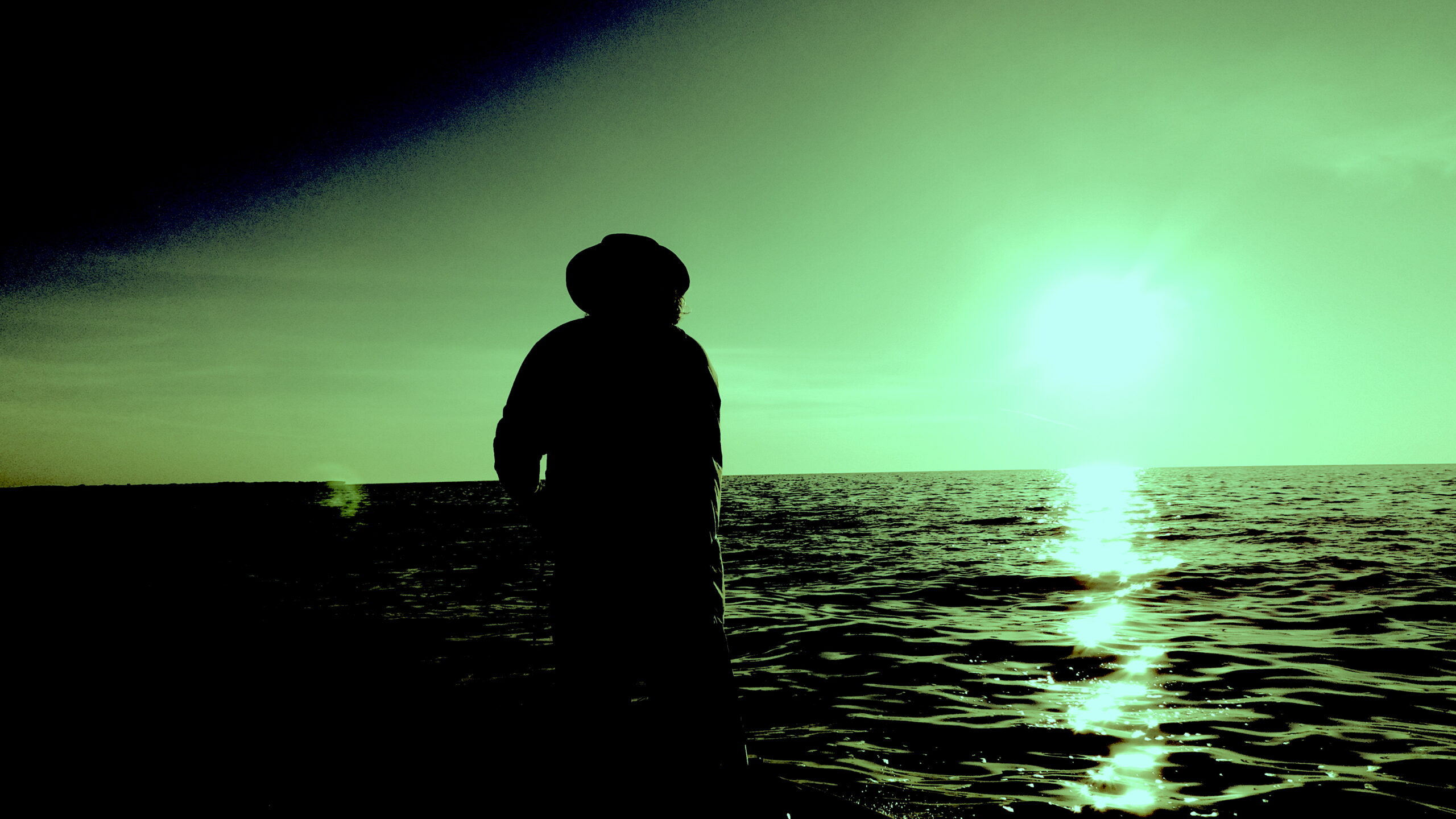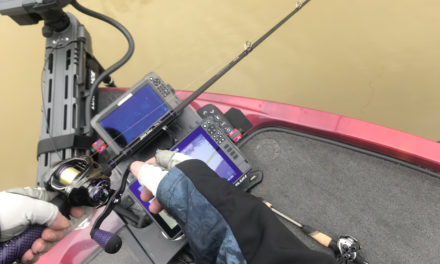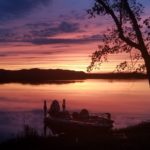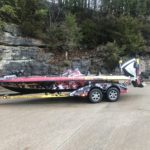When it comes to bass fishing, there is nothing I dread more than August in the southern reservoirs. For years, I would travel to New York for the majority of the month to fish the cool waters of Lake Champlain, or the St. Lawrence river. Occasionally I would switch it up and find myself camping on the shores of the Wisconsin stretch of the Mississippi River.
To be clear, it’s not the brutal heat, the unrelenting sun, lack of wind, absence of current, or the general belligerence of the bass that irritates me, it’s the crystal clear water.
But lets put August in perspective. In nature, every creature has limitations when it comes to heat, or cold, light, clarity, or some other environmental factor that has a direct effect on a natural biorhythm. Where southern reservoirs are concerned, these limitations are present twice per year…February and August. Essentially these months exhibit the temperature and light extremes in this area of the country. But it is important to remember that these scenarios are not diametric opposites. Because of the southern latitude, and more importantly, where Kentucky and the southern states fall in terms of the jet stream, the winter months, while cold, are not wholly inconvenient for the bass.
This is a simple matter of fish tolerance.
While it is exceedingly difficult to circumvent the cold period, due to the relatively uniform low temperatures of reservoir waters even at depth, the fact that we are in southern waters limits the degree to which the water temperature drops in the first place. Add to this the fact that there are many 60 degree sunny days even in winter which temporarily warm the shallows presenting good opportunities for pursuing bass during a limited period of increased activity. So the winter months, while uncomfortable at times for the angler, is not really a huge issue due to the mildness of the geography.
Thus, the fishing, pound for pound, is actually far better in February than in August because the lake ‘never’ gets cold enough to shut down the bite. In fact, the bite during February is not shut down at all, but rather a matter of dealing with suspended fish in many cases due to the forage holding over deep surface water on the main lake.
This is the real issue and what leads to the float and fly, the open water swimbaits, etc.
The bass are biting, but they are biting in an area devoid of structure, and without an accessible bottom to work with. With the shorelines vacant in many cases, anglers tend to suggest the bite is shut off, but this is simply untrue. When we look at August, however, things change. The mild winter conditions of the south are offset by the extreme summer conditions we experience beginning in mid July, which begs the question of whether the bite shuts off in the southern resevoirs.
The answer here is again, no, it does not shut down, but it is significantly altered, but surprisingly this state of affairs does not originate due to temperature of the water, but rather the water clarity.
The net reduction in the bite is far more than winter because changes in water clarity dramatically effect fishing (in the south) more than temperature changes. Bass can escape warm water by increasing their depth. So temperature is not really the issue at hand. But they cannot escape water clarity. Once the sun is up, everything above the thermocline is in plain site.
For a bass, this is not a good situation, in any case, but particularly if you are a largemouth bass.
But at the same time, there is an essential factor that in many cases can make summer salvageable. This is the fact that there is typically a short top water bite in the morning and evening, and that fish strongly relate to the bottom, or overhead structure during the daytime hours.
Unlike winter, when the water is largely stained and in many cases outright opaque, the forage fish won’t venture into this water during daylight hours because of exposure, not discomfort. Thus, the open water forage fish bite becomes a night activity. As day approaches, the sight strike potential exists until the sun is overhead. Once the sun is up, the clear water becomes the most significant factor in many lakes, even more essential than temperature. At this time, forage fish and their predators seek cover. This is why the bottom and vegetation bites are consistent throughout daytime hours in nearly every lake in the south. It is also interesting to note that in stained southern lakes, there is a deep open water bite but it presents the same issues as the winter bite. It’s there, but relatively inaccessible. In many cases, its actually better to have the clear water because it drives the fish into an accessible area.
The importance of this fact cannot be understated.
Thus, while August is more fundamentally difficult in terms of conditions, and the limitations of fish, it also makes finding the fish more predictable, and catching them far more plausible…given the correct approach.
And this is really where summer fishing is largely misunderstood. And to explain that, lets get into pre-spawn/spawn/post spawn/fall fishing vs. summer and winter pattern. Over the past 10 years, pre/spawn/ post spawn, and fall pattern fishing has become infused with the term ‘power fishing’. This has not only gone mainstream, it has become embedded as a tenet in most fisherman’s mindsets on how one approaches strategy early in the year, and again in the fall.
The idea here is that if the bite is generally turned off, you can turn it back on again by triggering what is by definition an involuntary response from the fish. Does power fishing work? Absolutely. But there have to be a number of factors in place for it to function according to the plan. First, the bass have to be aggressive enough to respond to the stimulus. Second, you have to present the lure in close enough proximity to the fish to trigger the response. But what about finesse fishing? Here, the bite is generally turned off, and you turn it back on by triggering what is by definition a voluntary response from the fish. Does finesse fishing work? Absolutely. But there have to be a number of factors in place for it to function according to plan. First the bass have to be aggressive enough to respond to the stimulus. Second, you have to present the lure in close enough proximity to the fish to trigger the response.
Wait. That sounds the same…the only difference being the fish’s volition. This one aspect of both definitions is enough to confuse the entire fishing world. And both begin with an incorrect assumption.
The bite is never off. Ever. When bass go on a hunger strike, I will concede the bite is off, until then, it is always on. 24/7, 365 days a year, every year. Power fishing vs. finesse fishing get into why a bass hits a lure, and when someone gets a degree in bass psychology, talks to enough bass to finally get a clear picture, I will listen to the difference. For now, I have no concept of power or finesse fishing.
Its just fishing. Sometimes I admittedly am trying to anger a bass into action, especially when I bomb a spinnerbait onto the dome of a sunning bass in early spring, sure I might be looking for a reaction strike. Other times I am presenting a subtle worm in an innocuous fashion. These are strategic concepts. The issue I have with power fishing and finesse fishing is that they have become pattern tenets associated with times of the year and lake conditions.
So according to dogma I cant power fish in august, and I cant finesse fish in march.
No one would actually suggest this, but the manner in which they are presented results in this type of mindset, and this limiting mindset can wreak havoc on your thinking when you are on the water. Lets list some other myths while we are at it.
- You cannot run a spinnerbait in perfectly calm water.
- Green pumpkin, need I say more.
- Topwater cannot catch fish in winter.
- Crankbaits need to contact the bottom or structure to trigger a strike
- Black and blue only work at night or heavily stained water.
- Big fish are caught with big lures
- Tubes only catch deep water fish
- Jerkbaits only work during windy conditions
- The bite is best at first light
- Smallmouth can be found on the rocks
- Largemouths can be found shallow and in vegetation
Heres another one for you…
During the heat of summer, the fishing is only good in southern reservoirs at night.
Are these concepts wrong, yes. But they are not 100% wrong. These concepts point at tendencies, but under test are generally unreliable.
If you look at these maxims, and you have a lot of fishing experience, you know that spinnerbait bites come and go, and sometimes, that lure is on in clear calm water. I have watched fish lazily swim 20 feet and then accelerate to warp speed to hit a spinnerbait. Fish hit lots of colors, not just green pumpkin. I have caught fish on the top in January. There are many days when the crankbait takes hits on the way down, or up from the bottom, but never on the bottom. Black and blue, for me anyway, has been successful in nearly every type of water at one point or other. Big fish hit all the same lures that any other fish eat. Tubes catch fish everywhere all year long. I still don’t know why a fish would eat a tube, but they sure love them. Jerkbaits, like the spinnerbait, are on or off, but the conditions vary. I used to think that the fishing was best at first light, and sometimes a particular bite condition is associated, but there are lots of bite conditions, and they occur all day long. And as far as where fish are located, they choose where they want to be, and I have never heard of any ‘no smallmouth’ signs in the grass, nor are there ‘no largemouth’ rock zones.
And finally, night fishing during the summer is not about the fishing being better at night, its about not dying of heat stroke, getting a sunburn, and perhaps even enjoying your time on the boat in the cool evening air. But make no mistake, the bite is on during the day.
But the daytime bite in the height of summer is not going to be a reaction bite. I think a better way to put it is that it is not an ‘action’ bite. And this has nothing, absolutely nothing to do with the heat. It is the clarity. I concretely believe that the clarity in the southern reservoirs is the problem during the late summer months. I mean, consider this question from the perspective of the fish. My home lake, the cruel and insurmountable Lake Cumberland, the Rubik’s cube of bass lakes, 1/2 the year this lake is either brown, or heavily stained. Then, at the height of summer, its clear as distilled water. Of course the bass are going to be sight shocked by this reality. These fish oscillate through a wide range of clarity levels. So much so that I personally believe that water clarity here is the prime variable in developing a fishing strategy.
So where are we on this August 1st morning. We know a few things.
- The bite is always on.
- The heat, while inconvenient, can be circumvented via depth.
- The water clarity is the prime variable.
So we are fishing against the limitation of water clarity once the sun is formally ‘up’, in generally deeper waters. The top water and swimbait bite is a given for the 6 to 7:30 am timeframe, and again from 8:30 to 10 pm. And of course there are always stragglers in the shallows or fish that don’t mind hotter water. Other variables might factor in, such as heavy overcast skies, rain, wind, etc. In such cases, everything I am suggesting below should be revisited. But assuming the water is clear, and the day is relatively horrible. ie. hot and calm, I see only one consistently reliable solution for the month of august.
The Carolina rig.
I wrote an article some months ago where I talked about my favorite summer rigs. The Tokyo rig, my favorite. The dreaded football rig, not my favorite. The elation of the flutter spoon typically one day a year. The drop shot, always good. The tube, always good. And of course, the Carolina rig.
It is August 1st and I have 5 Carolina rigs on my deck… Lets look at rest of the team before we get to the rigs.
- The spinnerbait. I have this on a Lew’s Pro TI rod, 6’10 MH. Lew’s Pro TI reel with 12 lbs floro. My favorite spinnerbait is the KVD finesse spinnerbait in 3/8 oz gizzard shad color.
- The California Swim Jig. This is a heavy hook structure swim jig that bounces off nearly anything without issue and stands up to heavy vegetation when present. I have this on a Lew’s Pro TI rod, 7’2″ M (I know its a bit soft for this bait, but I like to pitch it, so this rod is best of both worlds for me. I would use a custom pro in MH otherwise.) The reel is a Lew’s Pro TI with 12 lbs floro. My typical lure here is the Strike King tour grade swim jig in 3/8 oz, white color.
- The Tokyo rig. Here I have a 7’4″ Lews Custom Pro speed stick in Heavy power. A Lew’s superduty 300 reel with 12 lbs floro. I use a VMC Tokyo rig and just love the Strike King Zero 5″ stick worm in Watermelon. (go figure, the watermelon is just on this year…everywhere)
- Topwater. I have a Lew’s Speed stick, 6’6″ MH, Lew’s CustomLite SLP reel with 12 lbs mono, and I typically use a KVD sexy dawg in Chrome. Sometimes I use the Shizzle as well depending on cloud cover. I don’t throw the frog much down here. I kind of miss it.
I typically don’t use any of these rigs during august, except the topwater, and that’s just for an hour at best.
After that I have an assortment of rods and reels in the hold so I can improvise if necessary. I also have a Lew’s Customplus ledge raider and a BB1 reel if I want to throw the big crank baits.
But it does not matter. Beginning in early July, I shifted out of the Tokyo rig, tube, Texas rigs, even the drop shot, and made my way to the old staple of high summer.
Now I am in the thick of it, with 5 Carolina rigs on the deck to go with my 30 pounds of ice, 10 waters, 5 gatorades, and a whole lot of resolve. So here is how I set up the Carolina rigs.
- Lews Speed stick custom pro 6’10” MH, Lew’s custom lite, 10 lbs floro, 8 lbs mono, 1/8 ounce tour grade tungsten bullet, red bead, kvd perfect plastics 4” Ocho
- Lews Pro TI rod 6’10” MH, Lews pro TI reel, 12 lbs floro , 10 lbs mono, 1/4 oz tour grade tungsten bullet, red bead, kvd perfect plastics 4” game hawg
- Lews speed stick custom pro 7’4” H, Lews Superduty 300 reel, 20 lbs braid, 12 lbs floro, 1/2 oz tour grade tungsten bullet, red bead, 3” rage baby bug
- Lews custom pro 7’3” MH rod, Lews Custom pro hyper mag, 12 lbs floro, 10 lbs mono, 1/2 oz tour grade tungsten bullet weight, red bead, floating tube
- Lews Pro TI 7’4” H rod, Lews Pro TI reel, 12 lbs floro, 8 lbs mono, 3/4 tour grade tungsten bullet weight, red bead, Strike king ned Ocho
- Lews Custom pro 7’6” H rod, Lews Superduty 300 reel, 14 lbs floro, 12 lbs mono, 3/4 oz tour grade tungsten bullet weight, red bead, 4” strike king rage craw
Lets just get right to the bead. I always use a red bead. Period. I am superstitious in this regard. No one will ever talk me off the ledge that suggests that a red bead catches more fish.
It does…at least for me. A Carolina rig without that red bead would seem like a hopeless effort.
Beyond that, my Carolina rig setup is based on really 3 different fishing scenarios. I have my shallow water setup, and when I say shallow water I mean somewhere in the 8-17 foot range. This is 1 & 2. The Ocho is really a structure rock deal and the game hawg is light grass, choppy rock, etc. sometimes the 1/4 bullet is too much and gets hung up, so I might switch the hawg to the 1/8. I also use a Zero stick worm here a lot. I really like this manageable rod and reel combo though. The ungainly nature of the Carolina rig really gets me down. I tend to fish it a little faster than many anglers, so I like a smaller setup. As far as leader length, I rarely exceed 18 inches in these two and usually its about a foot.
I like number 3 because its all the help a Carolina rig can give with that 20 lbs braid. Plus I can feel every pebble on the bottom so it makes a generally boring fish somewhat interesting. (This of course is not actually the case. I get so enthralled in Carolina rig fishing that I am completely focused. I say its boring just for the fun of it, I don’t find any kind of fishing boring at all. I guess again that is the test for whether you should do this full time.) I use this rig to pull plastics through vegetation with maybe a 2 1/2 foot leader. Obviously there are limitations, if it is really thick for example, I will shift over to the swim jig rod, or maybe rig up some kind of finesse plastic on a Texas rig, which is why I carry extra rods and reels, but at this point of the summer, most fish are on the edge of the weed line so I need a rig that can handle the vegetation, but I am not planning on pulling a lure through the heart of it. All in all, this setup works great for what I need it to accomplish.
One note here, you need to be cool with the hook set. The braid can snap the floro, or rip the bait right out of the fishes mouth (more common). This is the epitome of reel until you tighten the line, then sweep the rod, with no hook set per se at all. Its good practice because with 1 & 2, I set more traditionally because of the light weight and the short leader. People ask me how I get away with using shorter, more flexible rods and this is how, the hook set needs to be motivated with these set ups.
Rigs 4 & 5 are designed for deep water . Typically 20-30 feet. I rarely ever fish deeper than 30 feet. I know people tell stories about taking fish out of 40+ feet of water, but my experience has been those fish are suspended. Sure you do get the occasional deep sea diving bass, friend of the kraken, but there are really good fish 20-30 feet and I can still somewhat feel the bottom and the strike at this depth. Note that I rarely use more than 3/4 oz weights regardless of how deep I am fishing. This is interesting because I use 1 oz, and 1.25 oz weights in Tokyo rigs all the time. But I don’t like the feel of a heavy Carolina rig. I seems like it prevents a solid hook set, even with a good sweep.
One reason is that I use a really long leader. Typically 3+ feet. Sometimes close to 5 if the water is super clear. So when a fish takes the lure, I need to tighten the line and then get a really good sweep, so fighting the weight is not what I need in that scenario. Plus with a 5′ leader, you can barely feel the fish take it. I have to fish it really, really, really slow. So slow. Like 1 inch at a time slow. little hops. tiny shake. All the while paying really close attention for any variation which would suggest a strike. The rod length here is really important, casting is super tough, but the sweep is also problematic. The firmness of the rods I am using is essential here because there is no solution to getting enough power for the hook set at this depth with a long leader.
All in all, setups 4 & 5 are just plain difficult to fish, and I lose a lot of fish on these rigs. It requires a lot of experience, especially in light of the fact that as I improve, I realize that there have been many times when I had a fish on and did not realize it. This is a practice imperative for me.
Why 5 carolina rigs. The answer is easy to provide on this one. The Carolina rig is the quintessential setup for clear water bottom fishing. I think the Tokyo rig suffers the same fate as the crank bait. Once the stain is back in the water, I am back to the Tokyo rig, which I believe to be an absolutely superior setup. The Tokyo rig catches much bigger fish than the Carolina rig. But that clear water just foils the plan. I could fish the drop shot, but its my experience that the fish don’t relate to the drop shot the way they do up north. The Texas rig is an option, but all that hopping and yo yo motion seems too pronounced for the conditions.
The only real competitor to the Carolina rig is dragging a tube. This is one of the reasons why I fish a floating tube on the Carolina rig, and I do drag a traditional tube on occasion. But in my experience, the Carolina rig out fishes the tube in the south, and I think the reason is the mono I use which allows the lure to drift just off the bottom, as well as react to rod movements. The tube seems to be on or off. I usually check. If its on I will fish it, but if I don’t get a hit in 3-4 casts, I will move straight to the Carolina rig without a delay.
I wish I could sit here and tell you all about my highly complex presentation via Carolina rig, but its really not the function of the setup. It is supposed to be subtle. Quiet. Without any extras if you will.
This is no frills meat and potatoes fishing. Its more about location than fishing technique in my mind. I select areas of the lake that exhibit a number of viable characteristics.
- Variable bottom structure. I don’t want to fish a vast field of sand, pebbles, rock, etc. Uniformness is bad in my mind, so I am looking for a particular depth, and then a lot of variation in close proximity. Fish like to associate with specific features, but those features change. Thus, finding lots of features in close proximity saves you from running up and down the lake all day.
- Current. This is my big one for Carolina rig fishing. When I am breaking down a map for August fishing, I exclude anywhere that is not current oriented. Yes, I agree the anti pattern suggests we look at quiet water as well, but in this case I need it to be close to current oriented areas. The reason here is biological, water with current will have better food opportunities and better oxygenation during the hottest months of the year. It will also allow a fish to go deeper in the water column without discomfort, and therefore keep that fish active as opposed to lethargic, which is what we are looking for.
- Quick access to shallow vegetation, or some other attractive feature. Living on a lake teaches you a lot about fishing just from sitting on your deck and watching fisherman at work. One interesting thing I see during the late summer months is the location of the night fishing boats. They are essentially focusing on Spring locations in pitch darkness. I think it breaks down into a split personally. Some fish come shallow at night, others chase the forage around in open water. In either case, I never night fish so it is not an issue for me, but locating an area near shallow forage areas does not hurt.
- Nearer to the dam is typically better than farther. This is objectionable I know. Awesome fish live on the main lake and in creeks far from the dam. But for me, as the summer presses on I find myself nearly always in sight of the dam unless I am searching for a particular water clarity. (Going up river for example.) But if I am Carolina Rigging, chances are that I can literally see the dam. Typically, the water here is at its clearest, and the current is typically pretty good. I also personally believe that the fish in the proximity of the dam are just bigger. It might be true, it might be a confidence thing. In any case, I have seen many a dam under the burning sun, dragging my little Carolina rig with absolute conviction. And its worked out so far.
Regarding technique, its pretty basic. I generally just drag the lure as slowly as I can. This is actually a game for me, how slow can I fish the rig. Sometimes I let it float for a time, maybe a little dart here and there (by little I mean 6 inches or so, everything is muted). I try different things and usually find one that works. I will say 75% of the time it is just a slow drag, and the bottom structure, current, and contour of the plastic I am using does the rest. Most of my hits come on the Ocho. A little worm floating on a very small hook does not present much of a perceived effort required to a bass. Though as I come shallower, a larger bait seems to be preferred. I think its because any fish roaming in shallower water is actively looking for food so it corresponds with the size of the meal vs. difficulty in acquisition principle.
Most importantly, I can tell you that I have faith in the Carolina rig. It catches fish, a lot of fish, in conditions where any other bait might result in nothing at all. You take a brutally hot, blue sky, sunny day and the Carolina rig can put fish in the boat. That confidence is hard to come by in August. I think with my setup, my willingness to fish both shallow and deep, in creeks and on the main lake, and around vegetation when I find it, and my willingness to be flexible with the rig also helps. Particularly due to the fact that I fish both as a search strategy, as well as a targeted approach. If I have any criticisms, it is the number of small fish that you catch and have to throw back. That and catching the wretched catfish.
I hate catfish.
In any case, August can be terribly difficult for a dedicated angler, but I think if you revisit the Carolina rig and be willing to take multiple versions to the lake, you will increase your chances to have a big day in the height of summer. Give it a try, and let me know how it works out.








